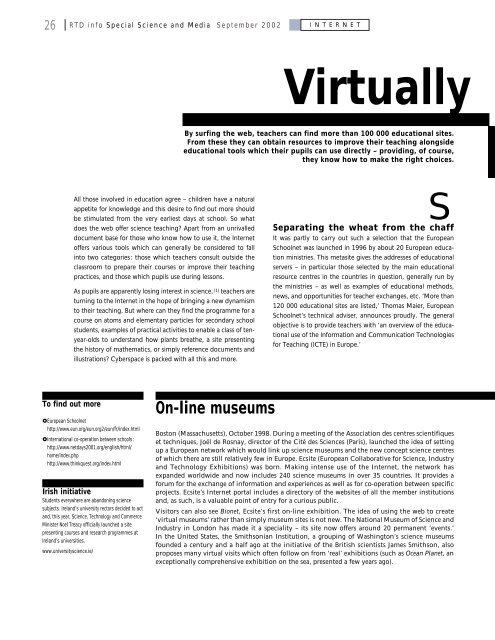RTD info - European Commission - Europa
RTD info - European Commission - Europa
RTD info - European Commission - Europa
Create successful ePaper yourself
Turn your PDF publications into a flip-book with our unique Google optimized e-Paper software.
26 <strong>RTD</strong> <strong>info</strong> Special Science and Media September 2002 I N T E R N E T<br />
Virtually<br />
By surfing the web, teachers can find more than 100 000 educational sites.<br />
From these they can obtain resources to improve their teaching alongside<br />
educational tools which their pupils can use directly – providing, of course,<br />
they know how to make the right choices.<br />
All those involved in education agree – children have a natural<br />
appetite for knowledge and this desire to find out more should<br />
be stimulated from the very earliest days at school. So what<br />
does the web offer science teaching? Apart from an unrivalled<br />
document base for those who know how to use it, the Internet<br />
offers various tools which can generally be considered to fall<br />
into two categories: those which teachers consult outside the<br />
classroom to prepare their courses or improve their teaching<br />
practices, and those which pupils use during lessons.<br />
As pupils are apparently losing interest in science, (1) teachers are<br />
turning to the Internet in the hope of bringing a new dynamism<br />
to their teaching. But where can they find the programme for a<br />
course on atoms and elementary particles for secondary school<br />
students, examples of practical activities to enable a class of tenyear-olds<br />
to understand how plants breathe, a site presenting<br />
the history of mathematics, or simply reference documents and<br />
illustrations? Cyberspace is packed with all this and more.<br />
S<br />
Separating the wheat from the chaff<br />
It was partly to carry out such a selection that the <strong>European</strong><br />
Schoolnet was launched in 1996 by about 20 <strong>European</strong> education<br />
ministries. This metasite gives the addresses of educational<br />
servers – in particular those selected by the main educational<br />
resource centres in the countries in question, generally run by<br />
the ministries – as well as examples of educational methods,<br />
news, and opportunities for teacher exchanges, etc. ‘More than<br />
120 000 educational sites are listed,’ Thomas Maier, <strong>European</strong><br />
Schoolnet’s technical adviser, announces proudly. The general<br />
objective is to provide teachers with ‘an overview of the educational<br />
use of the Information and Communication Technologies<br />
for Teaching (ICTE) in Europe.’<br />
To find out more<br />
#<strong>European</strong> Schoolnet<br />
http://www.eun.org/eun.org2/eun/fr/index.html<br />
#International co-operation between schools:<br />
http://www.netdays2001.org/english/html/<br />
home/index.php<br />
http://www.thinkquest.org/index.html<br />
Irish initiative<br />
Students everywhere are abandoning science<br />
subjects. Ireland’s university rectors decided to act<br />
and, this year, Science, Technology and Commerce<br />
Minister Noel Treacy officially launched a site<br />
presenting courses and research programmes at<br />
Ireland’s universities.<br />
www.universityscience.ie/<br />
On-line museums<br />
Boston (Massachusetts), October 1998. During a meeting of the Association des centres scientifiques<br />
et techniques, Joël de Rosnay, director of the Cité des Sciences (Paris), launched the idea of setting<br />
up a <strong>European</strong> network which would link up science museums and the new concept science centres<br />
of which there are still relatively few in Europe. Ecsite (<strong>European</strong> Collaborative for Science, Industry<br />
and Technology Exhibitions) was born. Making intense use of the Internet, the network has<br />
expanded worldwide and now includes 240 science museums in over 35 countries. It provides a<br />
forum for the exchange of <strong>info</strong>rmation and experiences as well as for co-operation between specific<br />
projects. Ecsite’s Internet portal includes a directory of the websites of all the member institutions<br />
and, as such, is a valuable point of entry for a curious public.<br />
Visitors can also see Bionet, Ecsite’s first on-line exhibition. The idea of using the web to create<br />
‘virtual museums’ rather than simply museum sites is not new. The National Museum of Science and<br />
Industry in London has made it a speciality – its site now offers around 20 permanent ‘events.’<br />
In the United States, the Smithsonian Institution, a grouping of Washington’s science museums<br />
founded a century and a half ago at the initiative of the British scientists James Smithson, also<br />
proposes many virtual visits which often follow on from ‘real’ exhibitions (such as Ocean Planet, an<br />
exceptionally comprehensive exhibition on the sea, presented a few years ago).

















